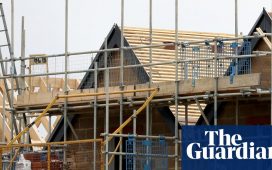Behind the glittery facades of London’s Selfridges and New York’s Chrysler Building, Austrian property billionaire René Benko assembled a financial time bomb.
Benko’s Signa Group, which bought stakes in the two trophy assets and amassed a €27bn ($29bn) property portfolio, racked up at least €13bn in debt during the years when the cost of borrowing was next to nothing.
“He gorged himself on cheap financing left, right and centre,” said one European property executive.
The decision to go all-out during the era of cheap money left Signa dangerously exposed to the sharp rise in interest rates this year. JPMorgan estimates at least €4bn of the debt owed by two pivotal Signa subsidiaries is at floating rates. And rising interest rates have hammered commercial property values across the market, reducing the value of the assets used to secure Signa’s loans.
Signa Holding, the central company, filed for administration last week.
The group faces tough questions about its business practices and valuations but its unravelling is the most prominent symptom yet of a painful adjustment to higher interest rates across the multitrillion-dollar global commercial real estate sector.
Property owners prospered in the world of cheap debt that made real estate investment relatively attractive. But that high has led to a predictable reckoning.
“The scale of the cyclical reset in terms of real estate valuations is as big as the early 1990s or the global financial crisis,” said Alex Knapp, chief investment officer for Europe at $100bn global private real estate investor Hines. “This is a big one, if that wasn’t obvious.”
Unrealised losses
With the era of ultra-low interest rates over, property owners — from small private businesses to large public companies — face higher interest bills, falling valuations and in many cases a need for cash to pay down debts.
European property groups have emerged as a focus of trouble. Swedish landlord SBB cut a deal with Brookfield to raise funds and is facing angry bondholders demanding their money back. Germany’s Adler survived a UK court challenge by bondholders this year over its restructuring plan, as it tried to avoid insolvency.
Many property owners are sitting on unrealised losses. Tom Leahy, executive director at MSCI Research, estimated in September that about 50 per cent of London’s commercial real estate assets are now worth less than what they were acquired for. New York fared relatively better, with just a fifth under water, but many office owners there face steep losses.
Owners will do what they can to avoid crystallising those losses. Official valuations tend to lag behind market reality because they rely on evidence of other transactions, and dealmaking has stalled. The value of completed deals is down more than 50 per cent in Europe and the US in the third quarter against a year earlier, according to MSCI.
“Sellers aren’t selling something unless they have to. Buyers aren’t buying something unless it’s really cheap. To take something to investment committee, it needs to feel like a distressed deal,” the European executive said.
Property analysts at Green Street compiled a list of more than €3.3bn worth of UK and European office buildings that had failed to sell in 2023 after being put on the market, including Frankfurt’s Commerzbank Tower, saying the list was probably just “the tip of the aborted sale iceberg”.
What forces reality on the market is when loans come due, or covenants on loans are breached. Owners will try to discreetly cut deals with their lenders or privately sell some assets to raise cash. That process can be slow.
“People talk about a wall of refinancing but it never actually works that way. It will take a period of years for those discussions to work out,” Knapp said.
Refinancing struggles
The financial pain will not fall evenly across the wider property market. For some landlords seeking cash, the proliferation of alternative lenders since 2009 means there are debt funds ready to take up the slack left by the banks.
“In the past 12 months, suddenly, it’s like everybody realised that I don’t have to buy that asset for 100 per cent of the price, I can lend against that asset for 60 per cent. If it all goes wrong, I have priority security,” said Lisa Attenborough, head of debt advisory at Knight Frank. “I now have probably over a hundred credit funds on my books.”
New investors have piled into credit partly because straightforward purchases look tricky, since property values could drop further. Many investors think debt is a safer bet.
“Pricing an asset in a higher-for-longer world is tough. So finding buyers willing to take equity risk is equally tough,” said Max von Hurter, head of European M&A at real estate investment bank Eastdil Secured. “Credit deals are easier — investors can earn a very respectable return without taking the first dollar of exposure.”
But financing is not available for everyone.
Signa faced €1.3bn of loan maturities in 2023 that it struggled to meet despite frantic talks with lenders and prospective new investors.
Assets with decent rental prospects — such as warehouses, residential buildings and the top slice of offices — will find refinancing easier.
The difference is between assets that need to see their value correct, and those whose value is expected to be wiped out.
“We are actually seeing assets becoming stranded with a velocity that we have never seen in the market before,” said Raimondo Amabile, co-chief executive of PGIM’s $210bn real estate business. “No one wants to lend against a stranded asset.”
Amabile said the calculation for owners of potentially stranded offices was “completely different”. “I am not going to throw a penny into this. It is basically a bank [problem],” he said.
Some assets will struggle because they have been loaded down with too much cheap debt that needs to be refinanced, even if they have decent tenant demand and rents.
Even the largest investors have cut their losses on some office buildings, including Brookfield’s decision this year to default on two Los Angeles towers. Office towers in New York have changed hands for less than the value of the land they sit on, as investors look for alternative uses for obsolete buildings.
The storm facing office owners, particularly in North America, combines a sharp drop in demand and the need for significant spending to upgrade outdated buildings, on top of the wider real estate downturn and rise in debt costs. Knapp said it amounted to a “little global financial crisis for secondary offices”.
Trouble in Europe
The storm is also intensifying in Germany. Signa’s troubles will deal another blow to the country’s market, further curtailing banks’ appetite to lend to commercial real estate.
“There is going to be a little bit of a fire sale, but not to the extent that it is going to bring down banks,” said Peter Papadakos, head of European research at Green Street. “Signa is not systemic to the wider real estate market. Where the real shitshow is going to be is specifically in Germany, and in offices.”
Still, lower inflation figures for October and increasing market bets that rates will be cut earlier than previously thought have fortified private hopes among some in the real estate sector that they can ride out the downturn. European real estate stocks have risen almost a quarter since the end of October as investors adjust their expectations.
Real estate veterans point out that the industry functioned for decades with higher rates. The challenge for an asset class that relies heavily on debt is navigating the shift after more than a decade of ultra-cheap borrowing.
“It takes a while for people to come down from the excitement of a low interest rate environment,” said Philip Moore, head of European real estate debt at Ares. “You are seeing the slow dawning of the fact that what we had over the past 10 years with a low interest rate environment was more of a blip than the norm.”













